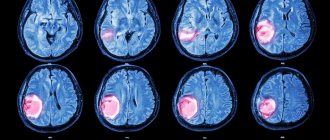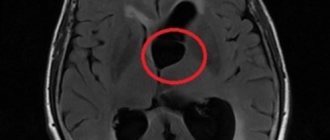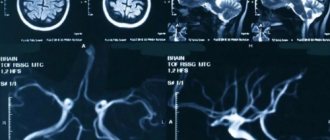Hospitalization and treatment under the compulsory medical insurance quota. More details after viewing the pictures.
Brain tumors can be benign or malignant; the latter are aggressive in nature and pose a significant threat to life. Neoplasms form inside the skull due to abnormal disturbances in the cellular genetic apparatus, which leads to uncontrolled growth of tissue structures. Atypical cells are formed from normal ones as a result of mutations, exposure to physical, chemical or other factors. These can be various cells of brain tissue, for example, neurons, glial cells and others. Often, metastasizing cells formed from cancer of other organs enter the brain, which leads to the formation of secondary malignant tumors. The main treatment involves surgical removal of pathological foci, additionally radiation and chemotherapy are prescribed, as well as drugs to relieve negative clinical manifestations.
Indications for surgery
In most cases of brain tumors, surgery remains the main treatment method. Most tumors respond poorly to chemotherapy. In addition, many drugs do not penetrate the blood-brain barrier. Radiation therapy does not provide radical treatment, and without tumor removal, relapse of the disease is only a matter of time.
Absolute indications for emergency operations:
- Increasing syndrome of intracranial hypertension, which is fraught with brain dislocation, herniation and death from respiratory or circulatory arrest
- Fundus congestion and progressive optic nerve atrophy, when a brain tumor threatens vision loss
- High probability of disruption of other important brain functions in the near future
The remaining patients undergo surgical interventions as planned. In many cases, this treatment can prevent the severe consequences of a brain tumor.
All operations are divided into radical and palliative. Radicals set as their goal the cure of the patient or the achievement of the longest possible remission. Palliative treatments are carried out with the aim of eliminating certain syndromes caused by cancer. However, they do not affect life expectancy and do not aim to cure the patient.
Examples of such operations include:
- CSF shunt operations to eliminate increased intracranial pressure
- Introduction of devices for periodic pumping out of cyst contents
- Decompressive craniotomy
To perform a radical operation, the surgeon must have sufficient visibility, and the tumor should not be located too deep. Otherwise, it will not be possible to reach it with gentle access.
Radical surgery to remove a brain tumor can be:
- Total
- Subtotal
- Partial
Total and subtotal operations are possible when the tumor is located outside the brain. These are neuromas, meningiomas, pituitary adenomas, and some gliomas. In recent years, radical operations have become increasingly successful in developed countries.
Microscopic neurosurgery has made it possible to dissect nerves and vessels located inside a tumor, or to separate tumor tissue from vital structures of the central nervous system.
Select a specialized clinic and treatment
Characteristic symptoms
The tumor grows inside the skull and begins to compress the brain. As a result, not only those departments that are in close proximity to the outbreak suffer, but also those that are located at a distance. The larger the tumor, the higher the intracranial pressure, and the higher the likelihood of cerebral edema. All this leads to a number of symptoms:
- headache;
- nausea and vomiting;
- blurred vision;
- decrease in the functions of the nervous system, which gradually leads to loss of coordination of movement, deafness, deterioration in the functioning of taste and olfactory receptors;
- numbness of the face;
- paresis of facial muscles;
- problems with swallowing;
- abnormal movement of the eyeballs;
- paralysis;
- speech problems;
- mental and intellectual disorders;
- visual and auditory hallucinations;
- epilepsy;
- convulsions;
- hormonal disorders.
Features of neurosurgical interventions for oncological formations of the central nervous system
Surgeries for brain tumors have many features. The main one is the impossibility of observing the principle of ablastics. This is a set of measures that are aimed at preventing relapse and metastasis of the tumor. Ablastics involves removing the tumor without touching the affected tissue. The doctor captures the lymph nodes, lymphatic and blood vessels, as well as a few millimeters of healthy tissue adjacent to the tumor. But if in the case of tumors of other localization this is possible, then in the case of brain tumors the operation cannot be performed in this way. Because the removal of healthy nerve tissue will result in severe neurological deficits after surgery, and sometimes the death of the patient. Therefore, in most cases, during surgery, the brain tumor is not completely removed. And not only microscopically, but also macroscopically. Some parts of the tumor are often located in areas of the brain that are too sensitive or cannot be accessed. After all, in order to penetrate the tumor, the doctor is forced to dissect the tissue covering it. And this is dangerous for the patient.
Removal of the tumor is carried out by fragmenting it. For this, various surgical instruments are used, such as nippers, vacuum suction, and ultrasonic disintegrator. If surgery is performed on a benign brain tumor, it is likely that there will be no relapse even if the removal is incomplete. Because such tumors grow very slowly. But malignant tumors are characterized by infiltrative growth and often produce foci located at a considerable distance from the main tumor mass. In this case, after removal of the brain tumor, radiation and chemotherapy are of utmost importance in further treatment.
Sometimes radiation is given before surgery to remove a brain tumor. Most often, when cancer spreads to the facial part of the skull and paranasal sinuses. After irradiation, the tumor decreases in size. Therefore, surgery may become more effective.
Rehabilitation goals
The objectives of the program include preventing metastasis and relapse of cancer, reviving lost functions, and activating thought processes. Fortunately, the human brain has great potential for recovery if its structures are not permanently damaged. For example, a violation of the part of the cortex responsible for speech is compensated by training fine motor skills. At the time of brain regeneration, growth factors are produced, which not only recreate damaged fragments, but also stimulate the growth of new ones. Therefore, the main mission of neurorehabilitation is to provide the brain with external stimuli and appropriate medical support.
Cognitive rehabilitation is aimed at renewing conversation skills, long-term and short-term memory, and the ability to concentrate and maintain attention. For this, nootropic drugs are used in conjunction with gaming techniques (putting words together from puzzles, writing diaries). If complete restoration of functions is impossible, every effort must be made to adapt the person to the limitations that have arisen, which will make his life much easier.
How to remove a brain tumor
Most often, one of two operational approaches is used:
- Craniotomy or osteoplastic craniotomy
- Craniectomy or resection trepanation
In the first case, which is used more often, the doctor cuts out a fragment of the skull, and after the operation puts it in place. And with a craniectomy, the doctor simply removes a fragment of bone. The defect is closed with a graft or synthetic materials.
Whenever possible, during surgery to remove a brain tumor, try not to cut the brain tissue. But sometimes this cannot be avoided. When the cancer is located inside the brain or ventricles, incisions are made in silent areas. Including in cases where this leads to an increase in the length of the incision.
How long surgery to remove a brain tumor lasts depends on the type of surgery performed and the characteristics of the clinical situation. It can last less than 1 hour. In other cases, it lasts several hours.
What type of anesthesia will be used during the operation?
General anesthesia is often used, which is especially important for precise tumor removal because you must remain absolutely still. Under general anesthesia, you will be unconscious throughout the operation. This type of anesthesia is called anesthesia
Some operations are performed under the supervision of an anesthesiologist using sedatives without anesthesia. You are given medications to relax you and block pain, but you remain either conscious or in a superficial unconscious state from which you can be easily awakened when needed during surgery. This allows for direct feedback from you, which can be extremely important. This is often called the AWAKE operation or "wake" operation and is discussed in more detail below.
Minimally invasive surgeries
Some surgeries do not require any incisions in the scalp. For tumors of the pituitary gland (usually adenomas), intervention is often carried out through the nose. They can also be performed for cancer located at the base of the skull and for craniopharyngiomas.
This approach is called transnasosphenoidal. These are endoscopic operations. They are possible when the oncological formation is localized in the area of the sella turcica (part of the sphenoid bone).
An operation to remove a brain tumor using a transnasosphenoidal approach is performed as follows: instruments are inserted through the nose, and trepanation is performed first on the lower and then on the upper wall of the main sinus. The upper wall just forms the sella turcica. Therefore, the doctor immediately gains access to the pituitary gland and has the opportunity to remove the brain tumor. Oropharyngeal access is less commonly used. It's called transclival. Meningiomas and chordomas are removed in this way. Sometimes a translabyrinthine approach is used. This method is used to remove a brain tumor due to intracanal neuroma of the eighth cranial nerve.
Stage 4 inoperable brain tumor – what is it?
Sometimes a patient is diagnosed with an inoperable brain tumor. This means that it cannot be operated on. There may be several reasons for this.
Generally, removal of brain tumors is avoided if:
- They're too big
- Located in functionally active areas of the brain
- Have a difficult-to-reach location (deep in the brain or at the base of the skull)
- They are a relapse of malignant oncological formation
In addition, for some histological types of brain tumors, surgery does not improve the prognosis. Therefore, it is abandoned in favor of radiation therapy and radiosurgery. For example, surgical treatment is ineffective for lymphomas and germinomas.
In addition, an inoperable brain tumor may be determined by the patient's condition. Surgeries are not performed on seriously ill patients or those in the terminal stage of the tumor process. If a tumor in the brain is a metastasis, then the person is not operated on if metastatic foci are also found in other internal organs.
They try not to perform surgery if it is assumed that other treatment methods can provide the same effect. Because surgical treatment requires long-term rehabilitation and carries greater risks than radiation therapy, chemotherapy or radiosurgical methods for treating brain cancer.
Select a specialized clinic and treatment
After operation
How long rehabilitation lasts after removal of a brain tumor depends on the type of surgery performed and the patient’s condition. In the early postoperative period, patients in German clinics are provided with high-quality care. A person performs special exercises while lying down to improve blood flow in the tissues. He starts walking as early as possible. The patient often feeds through a nasogastric tube.
Rehabilitation after removal of a brain tumor using a transnasosphenoidal approach is usually short. The patient is not even transferred to the intensive care unit. After waking up from anesthesia, he is in the general ward. The next day the patient can walk, and a week later he is discharged from the hospital.
If a transcranial approach is used, early postoperative recovery lasts longer. A person spends at least 1 day in the intensive care unit. Then he remains in the hospital for about 10 more days.
Removing a brain tumor can have quite serious consequences. Especially if the volume of the removed tumor was large, and if incisions were made in the brain tissue in areas of functional activity. Therefore, in order to eliminate the consequences of brain tumor removal, further postoperative recovery after discharge from the hospital is required. The earlier it is started, the better the results will be.
The main goals of rehabilitation after surgery to remove a brain tumor:
- Restoration of lost functions of the central nervous system
- Adapting to life with disabilities by acquiring new skills and changing living space
The consequences after removal of a brain tumor can be very different. This is a violation of a person’s mobility, a change in his psychological profile, a deterioration in the function of the senses (hearing, vision). Sometimes after treatment, a person may not be able to read, speak, or make precise movements with their fingers. It all depends on where the tumor was located and what parts of the brain were affected.
In Germany, good results of rehabilitation after neurosurgical intervention are achieved. They can eliminate or reduce most of the negative consequences of operations to remove a brain tumor.
Several specialists take part in the rehabilitation process, including:
- Rehabilitologist
- Physiotherapist
- Speech therapist
- Physical therapy specialist
- Psychotherapist
Rehabilitation specialists work not only with the patient, but also with his family members. Within a few months, adaptation to new living conditions usually occurs, and lost brain functions are restored either completely or partially.
How long you live after surgery for a brain tumor depends on its histological type, as well as whether it was completely removed. With the most malignant neoplasms, life expectancy can be only 1-2 years. With benign oncological formations, a complete cure is possible without any consequences and without reducing life expectancy.
Radiation therapy
At the end of its implementation, undesirable reactions may also occur due to the effect of gamma rays on nearby tissues, damage and decay of destructive cells. They develop 1-2 weeks after treatment, manifesting themselves in the form of:
- reduction of leukocytes, platelets, red blood cells;
- general intoxication – nausea and vomiting;
- dryness, peeling, itching of the skin of the head and neck, red spots, blistering rashes;
- hemorrhages, ulcers, soft tissue burns;
- hearing loss due to swelling of the auditory canal;
- diplopia (double vision);
- hair loss;
- loss of appetite;
- feelings of fatigue and malaise;
- impaired coordination and seizures.
This treatment is used both individually and in the postoperative period to remove residual structures growing into surrounding tissues.
One of the methods of radiation therapy is stereotactic radiosurgery, the principle of which consists in a single irradiation of pathological foci with high doses using the Gamma Knife and CyberKnife devices. It is an alternative to traditional operations and allows manipulations to be performed without general anesthesia, tissue excision and craniotomy. It is characterized by high accuracy and low risk of complications. The big disadvantage of the technique is the delay in the result, so in cases of acute symptoms it is not used.
Clinics and costs of neurosurgical intervention for various tumors
Most patients are interested in how much brain tumor surgery costs. It is clear that health is more important than money. But the point is not about saving, but about what treatment methods a person can afford, based on his financial capabilities.
People with above-average income always prefer to get treatment abroad. Because neurosurgical operations are very complex. They should be carried out in the best clinics in the world if you want to get a good result, long life expectancy after surgery and a minimum of neurological consequences.
When performing surgery to remove a brain tumor, the cost depends on what kind of intervention is performed:
- Resection of a brain tumor – 18,240 euros
- Non-invasive removal of tumors with the CyberKnife system – 25,245 euros
- Non-invasive removal of tumors with the Gamma Knife system – 12,343 euros
- Laser ablation under MRI control – 65,905 euros
- Neurological rehabilitation after completion of the main course of treatment – 904 euros per day
This may be more expensive than in hospitals in developing countries. Despite this, most people prefer to have surgery in Germany if they have the necessary funds for this, because their lives depend on the quality of the operation.
Leading clinics that perform surgeries for brain tumors:
- University Clinic named after. Goethe Frankfurt am Main, Department of Adult and Pediatric Neurosurgery
- University Hospital Münster, Department of Neurosurgery
- Charité University Hospital Berlin, Department of Adult and Pediatric Neurosurgery
- Beta-Klinik Bonn, Department of Neurosurgery and Interventional Neuroradiology
- University Hospital Freiburg, Department of Adult and Pediatric Neurosurgery
Physical activity
In the first postoperative days, light breathing exercises are performed to prevent hospital-acquired pneumonia, blood clots and other complications associated with physical inactivity. After the patient is transferred from intensive care and the condition is stabilized, attention is paid to restoring lost movements. If there are no contraindications, you are allowed to stand on your feet and try to walk. Then additional devices are added - weights, balls. Exercises should be performed without pain or fatigue.
It is important to constantly emphasize and praise patients in order to motivate them to achieve new successes, since most of them are prone to denial and depression. Positive dynamics will make it possible to understand that life is not over and a return to the previous existence is quite achievable.
Doctors at Doctor Borisov's Clinic provide assistance to people with disabilities of varying degrees of complexity. This is a difficult period both for those undergoing surgery and for their family members. But you need to be prepared for the fact that it will take a lot of time for a complete recovery or it will be impossible to achieve the previous level of condition. Our specialists try to do everything to get the most positive results. We invite you to a free initial consultation, where we can get acquainted with your problem and together find ways to solve it.
Organization of neurosurgical interventions in Germany
On the Booking Health website you can see how much surgery to remove a brain tumor costs in different clinics. The information provided is current today. We have direct contracts with all major German medical institutions. Therefore, you can always see the programs and prices that are currently offered.
Booking Health is ready to assist you in organizing a trip for treatment abroad. We will provide you with a full package of necessary services: assistance in paperwork, interpretation and translation, ticket booking, transfer from the airport to the clinic, etc. In addition, thanks to our services, the cost of surgery to remove a brain tumor will be 30-40% lower.
To use Booking Health services, leave a request on the website. We will call you back soon and help you decide on a clinic.
Contact Booking Health











